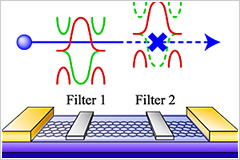
ページ読込中...

ページ読込中...

[English]
| 栗原 進 [教授] |  |
|
| homepage | http://www.kh.phys.waseda.ac.jp/ | |
| 専門分野 | 物性理論 | |
| 研究テーマ・研究活動 | ||
| ○冷たい原子系の理論 ○低次元量子多体系の理論 ○メゾスコピック系の理論 |
||
| ●日本物理学会 ●米国物理学会 |
||
固体や液体など、我々のまわりの物質は1cc あたり10の22乗個ほどの微粒子から構成されています。粒子の平均運動エネルギーが絶対温度に他なりませんから、十分低温になると粒子の運動量は温度の平方根に比例して小さくなり、従って、そのド・ブロイ波長は温度の平方根に反比例して増大します。これは、十分低温になるとド・ブロイ波長が粒子間の平均間隔よりも長くなることを意味します。このような状態を量子縮退と呼びます。
こういう状況になると、パチンコ玉のような古典的粒子性は失われ、量子力学的粒子がもつ波動性が顕著になって、粒子集団を支配する量子統計的性質があらわになってきます。量子力学的粒子は、見慣れた古典的質点からは想像も付かぬような風変わりな性質を持っており、きわめて排他的な性格を持つフェルミ粒子と、逆にきわめて協調的なボース粒子の二種類があることが分かっています。
全ての原子の性質を決定し、世界中のコンピューターの中でも大活躍をしている電子は代表的なフェルミ粒子で、金属中の電子が量子縮退を起こす温度は数万ケルビンです。従って室温のような低温極限(!)では、電子達は互いに同じ状態に入らぬように細心の注意を払っているかのように行動します(パウリ排他律)。電気伝導、光の反射など、金属の主要な性質は、こういう描像に基づく理論で完全に理解できます。また、ある種の金属では、数ケルビン程度の低温で、互いに時間反転の関係にある二つの電子が束縛対を作ることにより、超伝導という現象があることも分かっています。クーパー対と呼ばれるこの電子対は、電子自身とは全く逆に、きわめて協調的なボース粒子の性格をもっており、従ってすべてのクーパー対の重心が同じ状態をとることが許されます。すべてのクーパー対の重心が同じ運動量をもって運動している状態、それが超伝導電流が流れている状態です。この状態では電子の個別的な運動が禁止されているために電子散乱が起こらず、従って、電気抵抗なしに電流が流れます。
このような超伝導現象が、単純な金属以外の化合物で、しかも100ケルビンを越える高温で起こることが、20年ほど前に発見され、またごく最近では、超伝導現象の不倶戴天の敵と目されてきた鉄などの磁性元素を主成分として含む新しいタイプの超伝導体が日本で発見され、その機構を巡って熱心な研究が進められています。
更に、10年ほど前からはLi、 Na、 Rbなどのアルカリ原子からなる希薄な気体を、百万分の1ケルビン以下という超低温で量子縮退させる実験も行われるようになりました。この系はレーザー光や磁場を用いて量子流体の性質を自在に制御できるという素晴らしい性質を持っており、物性物理学の新しい分野が大きく開けつつあります。
私達の研究室では以上のように、様々な系それぞれの特性温度に比べて低温で見ることのできる量子多体現象の理論的研究に取り組んでいます。
| Susumu Kurihara [Professor] |  |
|
| homepage | http://www.kh.phys.waseda.ac.jp/ | |
| research field | Long-range order and collective excitations in fermionic and bosonic systems | |
| research keywords | ||
| Macroscopic quantum phenomena and associated quantum fluctuations at mesoscopic scales Superfluidity and magnetism in low dimensional metals and cold atomic gases Transport phenomena in graphene and carbon nanotubes |
||
| link | ||
We are primarily interested in how symmetries, interactions, and quantum laws governing microscopic constituents of a material determine the ground state and collective modes on a macroscopic scale. Our recent research areas include cold atomic systems, low-dimensional electronic systems, and strongly correlated electronic systems.
Cold atomic systems consisting of fermionic or bosonic alkali atoms are unique and promising in that both single-particle potentials and two-particle interactions can be precisely controlled by laser fields or magnetic fields. This implies that we can realize almost any many-body system at will, leading to the possibility of direct examination of the precise solution of a given many-body system, an enormous boost to the checking approximation methods we are forced to adopt in analytical calculations.
In one-dimensional systems, we are often able to solve quantum mechanical problems precisely. However, in the case of a Bose-Einstein gas of bosonic alkali atoms with repulsive two-body interactions, the exact results on tunnel effect show a totally unexpected feature: probability of phonon tunneling under a given potential barrier shows an increase with decreasing energy, not the typical decrease well-understood with the famous WKB formula, ultimately reaching unity in the low energy limit. This phenomenon, now known as anomalous tunneling, was solved analytically by our group for the first time. It is now understood as a manifestation of the gauge symmetry of the bosonic superfluid.
Another recent result also concerns symmetry, but involving the spatial inversion symmetry in a graphene nanoribbon. Graphene, a single sheet removed from layered graphite, is expected to serve as an ideal material for future electronics with exceedingly high carrier mobility. However, because it is a zero gap semiconductor, it presents the drawback of difficult control of electric currents. We propose a simple solution to this problem involving a nanoscale ribbon of graphene a graphene nanoribbon with an even number of carbon zigzag chains across its width. This ribbon has mirror symmetry with respect to its centerline and preserves the parity of wave functions with respect to the mirror operation. By combining this fact with the parity structure of two bands touching at the Fermi energy, we found that our system can act as a band filter, preventing tunneling between electronic bands of different parity and allowing the perfect conductance between bands of common parity. This result can be directly applied to practical applications involving producing a finite gap at the Fermi level, thereby controlling electric current along the ribbon. This result may open new possibilities for graphene nanoribbon electronics.
 An illustration of current suppression by parity effect as proposed herein. The parity effect prevents tunneling between electronic bands of different parity and allows perfect conductance between bands of common parity, an effect that may prove useful in controlling band gaps. The figure is adopted from a web page at Nature Asia-Pacific that introduces our paper published in Phys. Rev. Lett.
An illustration of current suppression by parity effect as proposed herein. The parity effect prevents tunneling between electronic bands of different parity and allows perfect conductance between bands of common parity, an effect that may prove useful in controlling band gaps. The figure is adopted from a web page at Nature Asia-Pacific that introduces our paper published in Phys. Rev. Lett.
Red and green lines represent even and odd electronic bands, respectively.
(http://www.natureasia.com/asia-materials/highlight.php?id=437)